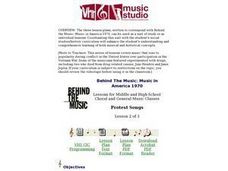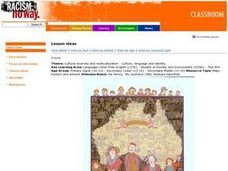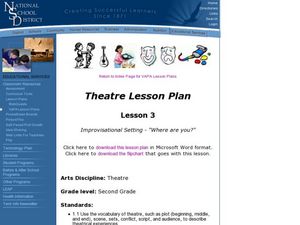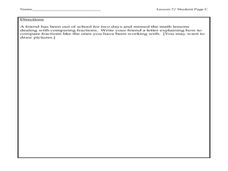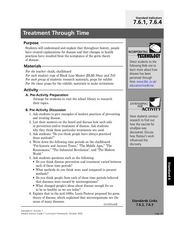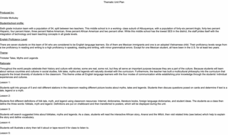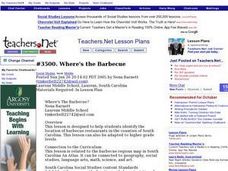Curated OER
Music in Advertising
Young scholars study the effects of advertising on the music industry.
Curated OER
Protest Songs
Students analyze and perform an American social protest song. They describe its historical setting, consider the effectiveness of the music and recognize that popular music is a reflection of American culture.
Curated OER
The Billy Goats Gruff and the Days of the Week
First graders explore the days of the week. In this days of the week instructional activity, 1st graders listen to the story The Billy Goats Gruff, then act out the events by stepping on "rocks" that name the days of the week. Students...
Curated OER
Racism No Way
Students explore different cultural influences and their contribution to Australian identities. They reflect on their own backgrounds and making links with their peers, reflect on our heritage. Students view My family- My Australia,...
Curated OER
A Nero Wolfe Mystery
Discuss a Nero Wolfe mystery on brining criminals to justice. Secondary students will read the book A Nero Wolfe Mystery: The Doorbell Rang. They then will watch the movie depicting this story and answer discussion questions. There are...
Curated OER
Stories of Individuals in the Chinese Community: a Comparative Approach
Students focus on stories describing the experiences of several individuals in the Chinese community and compare them with the experiences of Chinese immigrants in the late 20th century.
Curated OER
Music With a Message
Students write a line by line analysis of a song which they feel expresses a powerful message that can change society for the better. They then present their analysis to the class in an oral report.
Curated OER
Leonardo da Vinci
Middle schoolers select appropriate tools and technology to perform tests, collect data, and display data. They construct appropriate graphs from data and develop qualitative statements about the relationships between variables.
Curated OER
A Flip of Life in the 13 Colonies
Fourth graders create a flip book illustrating the 13 original colonies. They study the growth and development of each of the three groups of the original colonies. They use maps to observe and interpret geographic information and...
Curated OER
Animal Classification
Third graders differentiate between vertebrates and invertebrates, and identify the main characteristics of mammals, fish, reptiles, amphibians, and birds. They sort and categorize different types of balls, discuss the characteristics...
Curated OER
What Can I Write About When I Can't Think of Anything To Write About?
Third graders write, illustrate, and publish a collaborative story. In this writing lesson, 3rd graders review story elements by reading stories written by professional authors and other students. They work in groups to write a...
Curated OER
Shange's Novel Betsey Brown & Jazz
Students read a work of fiction and investigate literary values and structure of the work. They demonstrate understanding of the family values, cultural and historical context of the novel;
Curated OER
The Adventures of Tom Sawyer: Parenting and Discipline
Students discuss discipline in The Adventures of Tom Sawyer and compare it to how children are disciplined today. In this comparisons lesson, students identify different ways parents discipline their children. Students identify...
Curated OER
Emerging Heroes
Twelfth graders define what a hero is and watch a video. In this hero lesson, 12th graders discuss the characteristics of a hero and list heroes and their attributes. Students read the poem Beowulf and identify characteristics of its...
Curated OER
Improvisational Setting - "Where are You?"
Second graders explore setting through improvisations. In this theatre lesson, 2nd graders perform a variety of improvisations in different settings and chart how they established the setting in the different environments.
Curated OER
Initial Fraction Ideas Lesson 7: Overview
Third graders recognize that the larger the denominator of a fraction, the smaller the piece you have. In this fraction instructional activity, 3rd graders compare fractions and order them from largest to smallest. Students complete an...
Curated OER
Treatment Through Time
Seventh graders explore how disease prevention and treatment changed throughout history. In this life science lesson, 7th graders create a classroom exhibit about this topic. They present their project to visitors.
Curated OER
Color and Spectrum
Students examine the spectra of light sources that have similar colors. In this light lesson students complete an activity using various lights in the classroom and discuss the colors and the heat generated.
Curated OER
Legends and Myths: Trickster Tales
Middle schoolers work in groups to research the characteristics of various myths and legends. They read tales, illustrate them, record oral storytelling efforts and write an original folktale. Students then invite parents to a dramatic...
Curated OER
Tuck Everlasting and Economic Decision-Making
Sixth graders use a decision-making grid and list the alternatives and criteria for deciding to drink the Water of Immortality. They examine advertisements and list the product for sale, where it is sold, and why consumers should buy it,...
Curated OER
Where's the Barbecue?
Learners identify the major landforms, regions and rivers on a map of South Carolina. They compare the locations of the major Native American groups in the state as well. They chart where barbecue restaurants are located and write...
Curated OER
Using Cinderella Stories to Study Venn Diagrams
Seventh graders read Cinderella stories and complete graphic organizers for the various versions. In this story analysis lesson, 7th graders read versions of the story Cinderella. Students organize the story's information using a variety...
Curated OER
SC Populations Along Major Interstates
Students examine the population among the interstates in South Carolina. Using the internet, they identify the counties and roads and compare it with their own drawing.
Curated OER
Immigrants & Community
Students examine how different groups of immigrants contributed to the growth of specific communities. After reading a novel, they keep a journal on the important elements found and create a map of the community portrayed. Using the...



